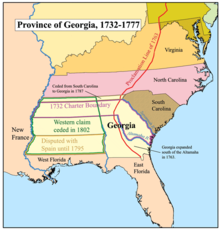
Back Colonias Meridionalas Occitan Colônias do Sul Portuguese Södra kolonierna Swedish Güney kolonileri Turkish

The Southern Colonies within British America consisted of the Province of Maryland,[1] the Colony of Virginia, the Province of Carolina (in 1712 split into North and South Carolina), and the Province of Georgia. In 1763, the newly created colonies of East Florida and West Florida would be added to the Southern Colonies by Great Britain until the Spanish Empire took back Florida. These colonies were the historical core of what would become the Southern United States, or "Dixie". They were located south of the Middle Colonies, albeit Virginia and Maryland (located on the expansive Chesapeake Bay in the Upper South) were also called the Chesapeake Colonies.
The Southern Colonies were overwhelmingly rural, with large agricultural operations, which made use of slavery and indentured servitude extensive. During a series of civil unrest, Bacon's Rebellion shaped the way that servitude and slavery worked in the South. After a series of attacks on the Susquehannock, attacks that were ensued after the group of natives burnt one of Bacon's farms, Bacon's arrest, along with other arrest warrants, were issued by Governor Berkely, for attacking the natives without his permission. Bacon avoided detainment, though, and then burnt Jamestown, in opposition of the governor previously denying him land in fear of native attacks, however Bacon hadn't believe his policies were entirely conventional, saying that they didn't ensure protection to the English settlers, as well as the exclusion of Bacon from Berkeley's social clubs and friend groups. The rebellion dissolved sometime in 1676, following Charles II's initial sending of troops to restore order in the colony. This rebellion influenced the view of the Africans, helping create a completely African servitude and workforce in the Chesapeake Colonies, alleviating primarily White servitude, a working-class that could be repugnant at times through disobedience and mischief. This also helped racial superiority in White regions, helping the poor White and wealthy White people, respectively, feel almost equal. It diminished alliances between White and Black people, as had happened in Bacon's Rebellion.[2]
The colonies developed prosperous economies based on the cultivation of cash crops, such as tobacco,[3] indigo,[4] and rice.[5] An effect of the cultivation of these crops was the presence of slavery in significantly higher proportions than in other parts of British America.
- ^ "The Southern Colonies". Retrieved 2014-10-17.
- ^ U.S. History. Houston, Texas: OpenStax College. 2014. p. 78. ISBN 978-1-947172-08-1. Retrieved 12 September 2023.
- ^ Boyer, Paul S. (2004). The Enduring Vision, 5th Edition. Houghghton-Mifflin. p. 64. ISBN 0-618-28065-0.
- ^ West, Jean M. "The Devil's Blue Dye and Slavery". Slavery in America. Archived from the original on 2012-06-14. Retrieved 2011-01-16.
- ^ Boyer, Paul S. (2004). The Enduring Vision, 5th Edition. Houghton-Mifflin. p. 77. ISBN 0-618-28065-0.